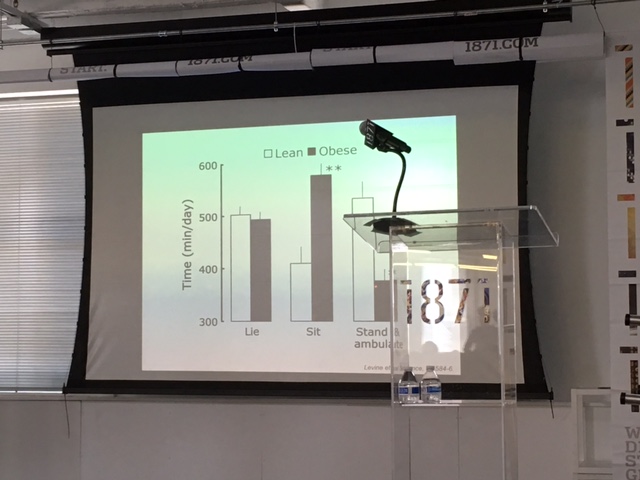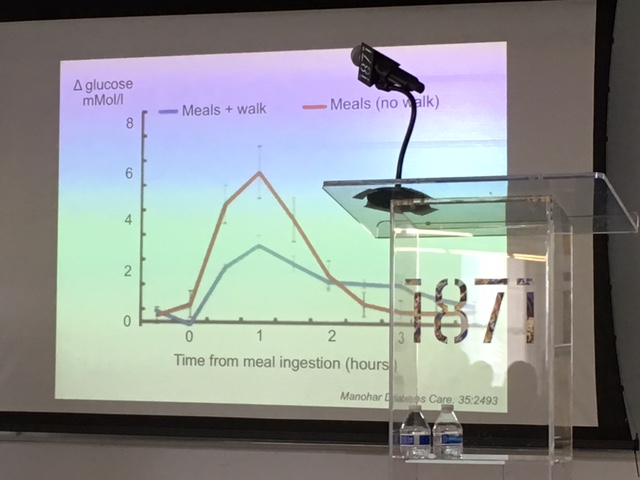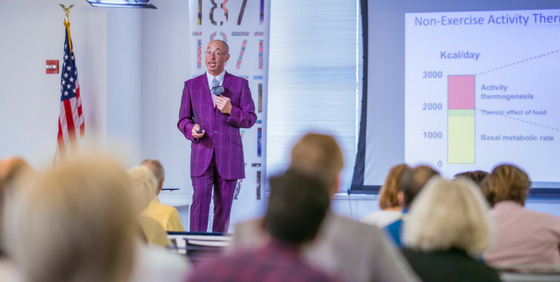Purple, plum, and maybe eggplant is the best description of the color of his suit. Whatever you call it, I knew I was in for a treat before Dr. Levine of the Mayo Clinic even said a word. In Chicago at the tech incubator 1871, he presented a lecture called “Standing or sitting is one of the most dangerous things you do each day.” Although I was initially skeptical of the overdramatic title of the talk, I quickly found myself enjoying Dr. Levine’s engaging personality and articulate way of discussing the research behind his claim.
The room was packed with designers, architects, and business people curious to understand more about seemingly benign activities like standing or sitting. Dr. Levine reiterated what most of us already know – our modern culture has created workplaces, schools, and communities that promote too much sitting and sedentary behavior. However, we may not understand as a society that “sitting disease,” as he called it, is linked to obesity and more than 30 chronic diseases. For example, diabetes is at epidemic levels, and the fear is that not only does this come at a financial cost to our country, but life expectancy, quality of life, and productivity are rapidly deteriorating because of our sedentary lifestyles.
His solution? Become a NEAT™-er person.
NEAT™ is an acronym that stands for “Non-Exercise Activity Thermogenesis” and measures the small activities we do throughout our day that are not exercising. Dr. Levine is the father of NEAT™ and has done some extensive research to support his claim that small activities add up to big results. By increasing our movement, or NEAT™, throughout our day, we can maintain our weight and stave off chronic disease.
Here are two ways he suggested doing that.
1 – Break up the day with 2-4 hours of non-exercise movement.
In the slide below, notice how the time spent in a sleeping position is similar in the lean and obese group; however, time in the “Sit” and the “Stand & Ambulation” positions are inversely related between the two groups. The people in the obese group spent significantly more time sitting each day than the individuals in the lean group. What were the people in the lean group doing during that time difference? Standing and moving.

Dr. Levine challenged us to make a conscious decision to turn on our NEAT™ each day and decrease our sitting time. For example, we should break up extended sitting at work by incorporating more standing and walking. However, he stressed that we don’t have to go from sitting at our desks to walking all day. Simply swapping out 2 hours of sitting for standing and walking is beneficial. It is ideal to aim for 4 hours of movement, and that could include walking meetings, brief standing and stretching after every hour of sitting, and standing, rocking, or fidgeting while we are on the phone.
While listening to him talk, I found myself reflecting on my school days. Isn’t it ironic that we were made to sit still and stop fidgeting in school as children, and now we have the research to prove how detrimental that behavior is to our health? We are faced with trying to unlearn those deeply ingrained habits and teach ourselves and our children that not only is continuous movement allowed, but it is also an integral component of a healthy lifestyle.
2 – Walk for 15 minutes immediately following a meal.
If you are like me, you’ve heard a rendition of this before. Take a walk after eating. I’ve always seen this tip about Thanksgiving dinner as a way to combat post-feast sleepiness, but there is a more compelling health reason to do this after every meal. Studies have shown that a 15-minute walk after a meal cuts blood sugar peaks in half. In HALF!
Let that sink in for a minute. Dr. Levine did, and he confessed that after learning this, he never eats a meal without going for a stroll afterward.

This struck me as such a simple, actionable way to impact diabetes risk. Even more interesting is that walking doesn’t have to be very fast to affect blood sugar. Leisurely strolling at 1.5 mph is enough to cut blood sugar peaks in half for 2 hours after a meal. Lower blood sugar means lower insulin in our system, and lower insulin means decreased food cravings and reduced-fat production in the abdominal region.
NEAT™-er Conclusion.
While I had previously read about Dr. Levine’s work on sitting disease, seeing him in person helped to solidify his research in my mind. I felt inspired that small changes in daily habits are within reach for all of us, which can have a huge impact on our health. I also felt honored to be there, representing an active seating solution that carries the NEAT™ certification.
Dr. Levin left us with this thought… Getting more movement in our day isn’t difficult, but it does require a mindset shift. With just a couple of small tweaks in our routine, we can go from a society of chronic sitters to one of the active movers. In turn, this can lower our risk of obesity and diseases like diabetes while increasing our overall wellness.
Best of all, we can start today by becoming a NEAT™-er person, just like Dr. Levine – even if we don’t own an eggplant suit.

Stevyn Guinnip has a masters degree in kinesiology and is a veteran in the fitness industry. She has a wide range of experience including NIH research, personal training, corporate wellness, cardiac rehab, group fitness, and launching fitness programs in both the US and Australia. Stevyn believes that if you seek wellness, you will find freedom. She also believes in the importance of the integrated core muscles including the (often neglected) pelvic floor muscles and diaphragm which are impacted by good posture, breathing, and movement.



